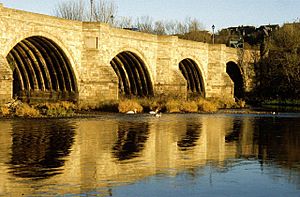Battle of the Brig of Dee facts for kids
Quick facts for kids Battle of the Brig of Dee |
|||||||
|---|---|---|---|---|---|---|---|
| Part of First Bishops' War | |||||||
 Bridge of Dee, pictured in 1997 |
|||||||
|
|||||||
| Belligerents | |||||||
| Commanders and leaders | |||||||
| Strength | |||||||
| 100 | 2,300 | ||||||
| Casualties and losses | |||||||
| 14 | 14 | ||||||
The Battle of the Brig of Dee was a fight that happened in Scotland on June 18–19, 1639. It took place at the Bridge of Dee near Aberdeen. This battle was the only major fight during the First Bishops' War.
In this battle, a group called the Royalists fought against the Covenanters. The Royalists were led by Viscount Aboyne. The Covenanters were led by James Graham, the Earl of Montrose. The Covenanters won the battle.
This war was part of bigger conflicts called the Wars of the Three Kingdoms. These wars happened in Scotland, England, and Ireland from 1638 to 1651.
Why Did the Battle Happen?
After the Protestant Reformation, Scotland had its own church called the "kirk." This church was Presbyterian, meaning it was run by Elders chosen by church members. This was different from Episcopalian churches, which were run by bishops appointed by the king.
In 1584, bishops were forced into the Scottish kirk, even though many Scots didn't want them. These bishops often supported the king's policies in the Scottish Parliament. So, arguments about bishops were about both religion and politics.
Most Scots, whether they supported the king (Royalists) or the Covenanters, believed that a good king was chosen by God. However, they disagreed on how much power the king should have over the church. Royalists usually thought the king should have more power. But many Scots also felt loyal to their own kirk. People's reasons for choosing sides were often complicated. For example, Montrose, who led the Covenanters in this battle, later became a Royalist. People often switched sides during this time.
When James VI and I became King of England in 1603, he wanted to unite the churches of Scotland and England. He thought this would help create one strong country. But the two churches had very different beliefs. Even Scottish bishops didn't like many practices of the Church of England.
King Charles I tried to make changes to the Scottish kirk. Many Scots strongly opposed these changes. On February 28, 1638, they signed the National Covenant. This was a promise to resist any changes to their church. Important leaders, including Argyll, signed it. In December, bishops were removed from the kirk.
King Charles I decided to use force to get his way. He planned to send an English army of 20,000 soldiers to Edinburgh. Another force of 5,000 soldiers, led by the Marquis of Hamilton, would land in Aberdeen. They would join Royalist troops led by the Marquess of Huntly. Finally, an Irish army would invade western Scotland from Carrickfergus.
However, King Charles's plans faced problems. He didn't have enough money. Also, many people in England actually supported the Covenanters. The Scots quickly took control of Dumbarton, which stopped the Irish army from landing. Montrose also took Aberdeen in March, so Hamilton's soldiers couldn't land there. In April, Royalist forces briefly took Aberdeen back after some small fights.
The Battle at the Bridge

Even though the main fighting was near the border, the northeast of Scotland was a Royalist area. It was behind the Covenanter lines. There had already been some small military actions there.
After a failed attack on June 15, Viscount Aboyne went back to Aberdeen. But most of his army was stuck on the other side of the River Dee. Between Aboyne and his main army was Montrose and his Covenanter army. In Aberdeen, Aboyne had only about 180 mounted soldiers and even fewer foot soldiers.
The Covenanters were coming towards Aberdeen from the south. To stop them, Aboyne placed 100 musketeers on the bridge. They were led by Lieutenant Colonel Johnstone. At the south end of the bridge, the gates were made stronger with dirt and earth. Royalist cavalry (soldiers on horseback) were also placed at the bridge. The river was high from rain, so it was impossible to cross anywhere else.
On June 18, the Covenanter army arrived at the bridge. They had 2,000 foot soldiers, 300 horse soldiers, and cannons. They started their attack, mostly using their cannons. Firing at the barricade all day didn't do much damage. Montrose saw that more attacks the next day also didn't break through.
Montrose then sent some cavalry up the river. They pretended to try and cross it. Aboyne fell for this trick. He sent all his cavalry to stop this fake attack. While Aboyne's cavalry was away, the Covenanters attacked the bridge again. Johnstone was hurt by flying pieces from the battle. Johnstone and his musketeers had to leave their positions. This allowed the Covenanters to capture the bridge.
Once Aboyne saw that the bridge was taken, he left Aberdeen and went towards Strathbogie. Both sides lost about fourteen soldiers in the battle.
What Happened Next?
The Covenanters took control of Aberdeen. However, the city still supported the Royalists who had lost. Many Covenanters wanted to destroy the city. But Montrose stopped them from doing this.
The day after their victory, Montrose received important news. The Treaty of Berwick had been agreed upon. This treaty officially ended the First Bishops' War.
In Stories
You can read about this battle in a historical novel called The Young Montrose by Nigel Tranter. It is also the setting for a traditional song called Bonny John Seton.

